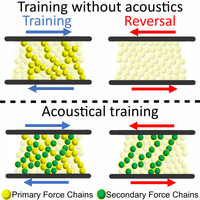在剪切力作用下将记忆植入声学训练致密悬架
IF 11.6
1区 物理与天体物理
Q1 PHYSICS, MULTIDISCIPLINARY
引用次数: 0
摘要
远离平衡状态的系统往往会保留其加工历史的结构记忆。在某些情况下,这种记忆会显著改变材料的反应。例如,结晶金属的加工硬化可以改变硬度、屈服强度和抗拉强度,从而防止灾难性的破坏。在流动系统中,结构可能会发生更大的变化,而加工历史的记忆是否也能在流动系统中得到类似的利用,人们对此还知之甚少。在此,我们展示了嵌入这种有用记忆的可行途径。我们的研究表明,将剪切致密悬浮液暴露在不同功率的声学扰动下,可以极大地调整剪切悬浮液的粘度和底层结构。我们发现,对于足够致密的悬浮液来说,在移除声学扰动后,悬浮液会发生剪切堵塞,来自最大压缩轴和最大扩展轴的剪切应力会反映或 "记住 "声学训练。由于这两个正交轴对总剪应力的贡献是对立的,因此有可能以令人惊讶的方式调整由此产生的悬浮响应。例如,我们发现不同训练的剪切悬浮液会表现出:(1)对相同声学扰动的敏感性不同;(2)剪切反转时瞬时粘度的数量级变化;以及(3)甚至在剪切停止时剪切应力的量级会增加。我们通过这些例子来解释每种行为的基本机制。然后,为了说明这种方法在控制悬浮特性方面的威力,我们演示了通过声学训练可以剪切干扰远低于剪切干扰阈值的流动状态。总之,我们的工作为在致密悬浮液中利用声学诱导记忆生成快速、广泛的可调材料铺平了道路。本文章由计算机程序翻译,如有差异,请以英文原文为准。

Jamming Memory into Acoustically Trained Dense Suspensions under Shear
Systems driven far from equilibrium often retain structural memories of their processing history. This memory has, in some cases, been shown to dramatically alter the material response. For example, work hardening in crystalline metals can alter the hardness, yield strength, and tensile strength to prevent catastrophic failure. Whether memory of processing history can be similarly exploited in flowing systems, where significantly larger changes in structure should be possible, remains poorly understood. Here, we demonstrate a promising route to embedding such useful memories. We build on work showing that exposing a sheared dense suspension to acoustic perturbations of different power allows for dramatically tuning the sheared suspension viscosity and underlying structure. We find that, for sufficiently dense suspensions, upon removing the acoustic perturbations, the suspension shear jams with shear stress contributions from the maximum compressive and maximum extensive axes that reflect or “remember” the acoustic training. Because the contributions from these two orthogonal axes to the total shear stress are antagonistic, it is possible to tune the resulting suspension response in surprising ways. For example, we show that differently trained sheared suspensions exhibit (1) different susceptibility to the same acoustic perturbation, (2) orders of magnitude changes in their instantaneous viscosities upon shear reversal, and (3) even a shear stress that increases in magnitude upon shear cessation. We work through these examples to explain the underlying mechanisms governing each behavior. Then, to illustrate the power of this approach for controlling suspension properties, we demonstrate that flowing states well below the shear jamming threshold can be shear jammed via acoustic training. Collectively, our work paves the way for using acoustically induced memory in dense suspensions to generate rapidly and widely tunable materials.
求助全文
通过发布文献求助,成功后即可免费获取论文全文。
去求助
来源期刊

Physical Review X
PHYSICS, MULTIDISCIPLINARY-
CiteScore
24.60
自引率
1.60%
发文量
197
审稿时长
3 months
期刊介绍:
Physical Review X (PRX) stands as an exclusively online, fully open-access journal, emphasizing innovation, quality, and enduring impact in the scientific content it disseminates. Devoted to showcasing a curated selection of papers from pure, applied, and interdisciplinary physics, PRX aims to feature work with the potential to shape current and future research while leaving a lasting and profound impact in their respective fields. Encompassing the entire spectrum of physics subject areas, PRX places a special focus on groundbreaking interdisciplinary research with broad-reaching influence.
 求助内容:
求助内容: 应助结果提醒方式:
应助结果提醒方式:


